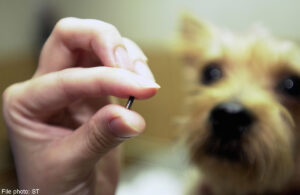Microchipping is one of the simplest yet most effective ways to ensure your dog’s safety. Dogs are naturally curious, and even the most well-behaved dogs can sometimes run off, get lost, or slip out of their collars. A dog microchip is a reliable and permanent way to identify your pet and significantly increase the chances of a happy reunion if they go missing. This article will explore how dog microchipping works, why it’s important, and what you need to know to keep your furry friend safe.
What is a Dog Microchip?
 A dog microchip is a small, electronic chip roughly the size of a grain of rice that is implanted just beneath your dog’s skin, typically between the shoulder blades. The procedure is quick, similar to getting a vaccination, and causes minimal discomfort. The chip contains a unique identification number that is linked to your contact information in a dog chip database. This database can be accessed by veterinarians, animal shelters, and other authorized personnel using a special scanner that reads the chip’s ID number.
A dog microchip is a small, electronic chip roughly the size of a grain of rice that is implanted just beneath your dog’s skin, typically between the shoulder blades. The procedure is quick, similar to getting a vaccination, and causes minimal discomfort. The chip contains a unique identification number that is linked to your contact information in a dog chip database. This database can be accessed by veterinarians, animal shelters, and other authorized personnel using a special scanner that reads the chip’s ID number.
Unlike collars and tags, which can break or be removed, a microchip stays with your dog for life, providing a permanent form of identification.
Why Should You Microchip Your Dog?
- Increases the Chances of Being Reunited Statistics show that microchipped dogs are far more likely to be reunited with their owners compared to dogs without microchips. If a lost dog is found and taken to a shelter or veterinary clinic, a quick scan of the microchip can provide the information needed to contact the owner. This can significantly reduce the time your pet spends lost and minimize the stress both for the dog and the owner.
- Permanent Identification A microchip is a permanent solution that cannot be easily lost or removed. Unlike collars and tags that can fall off or be intentionally removed, a microchip provides a secure way to identify your dog throughout their life. It’s a dependable backup even if your dog’s external ID tags go missing.
- Helps in Legal and Ownership Disputes In cases where the ownership of a dog is disputed, a microchip can serve as legal proof that the dog belongs to you. This can be crucial in situations where pets are stolen or if multiple parties claim ownership. The unique ID in the microchip is linked to your information, providing clear evidence of ownership.
- Meets Legal and Travel Requirements In some countries and regions, microchipping is a legal requirement for dogs. Many countries also require microchipping as part of their pet import regulations. If you plan to travel with your dog, a microchip is often necessary to meet the health and safety standards of your destination country. A registered microchip makes the process of traveling with your dog much smoother.
How Does a Dog Microchip Work?
A dog microchip is not a GPS tracker and does not provide real-time location data. Instead, it functions as a permanent form of identification that can be scanned by veterinarians and animal shelters. When a lost dog is found, they are scanned for a microchip, revealing a unique ID number. This ID is then checked against a dog chip database to retrieve the owner’s contact details.
The effectiveness of a microchip depends on keeping your contact information updated in the database. If you move or change phone numbers, it’s crucial to update this information to ensure a quick and successful reunion with your pet if they go missing.
What to Consider When Microchipping Your Dog
- Choose a Reputable Microchip Brand
It’s important to select a microchip from a well-known and trusted brand. Ensure the chip is compatible with the standard scanners used by veterinarians and shelters in your area. This will ensure that your dog can be easily identified if they are lost. - Database Registration is Essential
After microchipping your dog, you need to register the chip’s unique ID number in a dog chip database. Some veterinarians handle this registration for you, but you can also do it yourself online. Registration is crucial because an unregistered chip provides no way to link your dog to you. - Update Information Regularly
An outdated phone number or address can make it difficult for shelters to reach you if your dog is found. Make a habit of checking your registration details annually or whenever your contact information changes. Some databases will even send reminders to update your information.
Common Myths About Dog Microchips
- “Microchips are Expensive.”
Microchipping is affordable, and many animal shelters and veterinary clinics offer it at a low cost. Some organizations even provide free microchipping events. It’s a one-time expense that provides lifetime protection for your dog. - “Microchipping is Painful.”
The microchipping process is quick and only causes minor discomfort, similar to a standard vaccination. Most dogs do not even react to the procedure, and anesthesia is generally not required. - “Microchips Can Track My Dog’s Location.”
This is a common misconception. Microchips are not GPS devices; they do not provide real-time tracking. Their purpose is to provide identification if your dog is found.
Microchipping your dog is a small investment that can make a big difference. It is a reliable, permanent, and effective way to ensure your dog’s safety and increase the chances of a happy reunion if they get lost. By choosing a reputable microchip brand, registering your information in a dog chip database, and keeping it updated, you are taking a crucial step in responsible pet ownership.